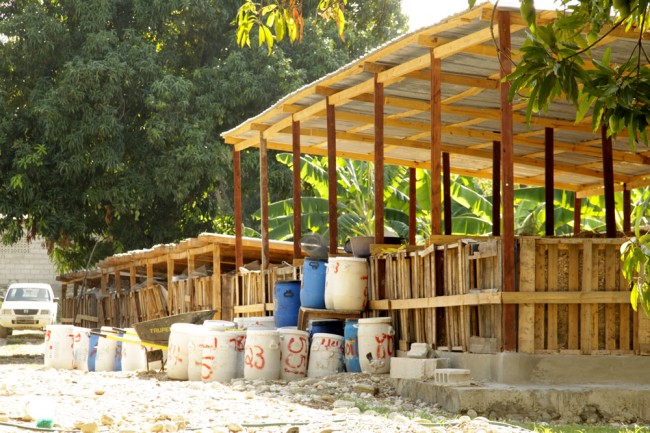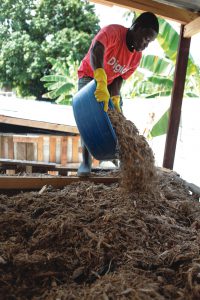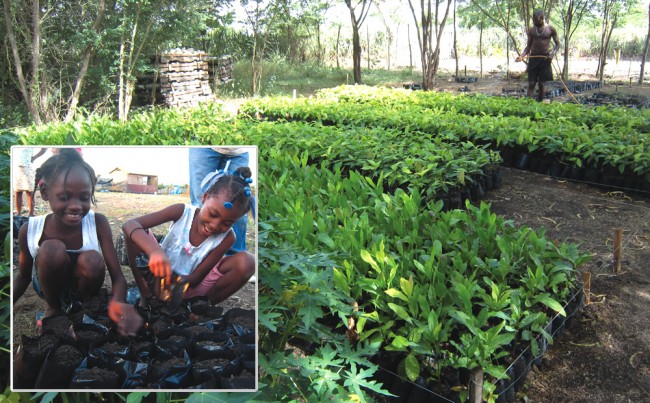A low cost system of resource management such as composting toilets is helping to mitigate many of Haiti’s social and ecological challenges.
Rich Flammer
BioCycle November 2012, Vol. 53, No. 11, p. 34

Two low cost composting facilities, including this one in Port-au-Prince, were built near toilets to minimize transportation of the material.
Geographic and geologic conditions have added to the island’s challenges, with hurricanes, monsoon-like rains and nearly two-thirds of its land mass with slopes of more than 20 percent. This combination of deforestation, steep land, torrential rains and high winds make the island particularly prone to erosion. More than 1.1 million cubic yards or 3,700 acres of soil are estimated to be lost annually. In many parts of the country, soil has eroded right down to the underlying bedrock. In short, less than one-third of Haiti’s land is arable, yet about two-thirds of its populace earns a living from agriculture. Half of the island is actually used for some kind of agricultural production, but the sorely depleted soil can sustain few crops.
“Although there is also a problem here with soils being nutrient depleted, the issue is more the fact that there’s been so many years of severe erosion from deforestation, there’s an actual lack of soil itself and organic matter in it, making compost as a soil amendment even more relevant in Haiti than in many other parts of the world,” says Sasha Kramer, who visited the island in 2004 as a graduate student and human rights observer. While visiting, Kramer quickly noted another profound challenge: very limited basic sanitation. Only 16 percent of Haiti’s population had access to toilets in rural areas and 35 percent in urbanized regions.
Multiple Benefits
Over the next several years, while finishing her degree and continuing to visit Haiti, she realized ecological sanitation could help mitigate many of the country’s challenges, both social and ecological, and began to develop what has evolved into an ingenious, simple, low cost system of resource management. “Collecting, composting, and recycling human waste into fertilizer for agriculture simultaneously helps solve so many problems that result from extreme poverty: poor public health, low agricultural productivity, malnutrition, environmental degradation, and waterborne disease — the country’s leading cause of death in children under five,” Kramer explained in an interview with National Geographic. “It also eliminates the need for chemical fertilizers that are fossil-fuel-intensive to produce and unaffordable for Haitian farmers.”
In 2006, the same year she received a Ph.D. in Ecology from Stanford University, Kramer cofounded Sustainable Organic Integrated Livelihoods (SOIL), a U.S.-based nonprofit organization, with her friend Sarah Brownell, an environmental engineer. SOIL was formed for “protecting soil resources, empowering communities and transforming wastes into resources in Haiti.” The organization’s work is based on the principle that “maintaining soil is the essence of sustainability from both environmental and social perspectives.” Kramer is SOIL’s Executive Director, as well as Adjunct Professor of International Studies and a Visiting Scholar at the Center for Latin American Studies at the University of Miami. SOIL designed and developed ecological sanitation, or EcoSan toilets, which it introduced to communities in Haiti.
The EcoSan toilets provided essential sanitation services to approximately 20,000 people displaced by the 2010 earthquake at the height of the disaster in Haiti, and continue to benefit 9,000 still living in displaced person camps, and some 5,000 people living in Cap-Haitien (in northern Haiti) and surrounding communities as well. It has developed and manages two composting sites, one in Port-au-Prince and another in Limonade (outside of Cap-Haitien, but servicing the toilets in the city). SOIL has also developed two experimental and demonstration gardens, does extensive training and outreach, and has become a go-to resource for other individuals and groups wishing to implement ecological sanitation in underserved communities throughout the world.
Toilet Options
SOIL’s compost substrate begins in specially designed toilets, all of which are built from locally available materials. Dry toilets, or Urine Diversion (UD) units, separate urine and excreta via a seat that allows the liquid to either flow into a “soak away pit,” or be collected and used in the experimental gardens or poured over an existing compost pile. Feces are collected in a 15-gallon drum under the unit. After each use, excreta are covered with bagasse, the shredded husks of sugarcane and a by-product of rum production. In addition to eliminating odor and flies, these materials are employed as bulking agents to facilitate aerobic microbial populations. Once full, drums are sealed for transport to the composting sites. Diversion of urine significantly reduces the amount of material (and weight) that requires transport, minimizing fuel costs. The lower moisture content of the material also helps minimize odors.

Sugarcane bagasse is added to the toilet waste at the composting sites as a bulking agent, and to absorb excess leachate and help control odors. Photo courtesy of SOIL
Double vault UD toilets, with each structure consisting of two rooms (male and female) and two toilets, cost approximately $2,500 to build. Temporary UD toilets (also with designated male and female rooms), utilized for emergencies, are built from wood, reused tarpaulins or other heavy plastic sheeting. These cost approximately $1,000 to construct.
With the help of Joe Jenkins, author of the Humanure Handbook, SOIL has also designed a composting toilet comprised of a simple wooden box with a collection receptacle beneath. These units can be built for less than $75. Like the UD system, materials are captured in a 15-gallon container, and cover material is applied after each use. As both urine and excreta are collected together, this system works better for children, the handicapped, or others who may find using a UD toilet a challenge. When full, containers are transported for composting.
Community acceptance of an EcoSan unit and engagement by residents is critical to these systems working effectively and consistent, conscientious management is required. Education of first-time users, regular cleaning of toilets, prevention of chemicals from being disposed in the drums, ensuring a supply of cover material is always available and applied after each use, and timely removal of drums are a few examples of maintenance tasks that must occur for control of odors and proper hygiene to be maintained. Through its experience with hundreds of installations, SOIL has learned, among many other things, that toilets built as a result of a formal request by a community are the best maintained, paid operators manage the toilets far better than volunteers, and a large volume and consistent source of cover/bulking materials must be sourced and always on-hand and available to users.
Low Cost Composting
In both urban and rural areas, SOIL has utilized simple, low-cost composting systems near toilets to eliminate the need for transporting material. A typical system involves construction of a rectangular structure using pallets or wood scraps built close to the toilet so drums can be emptied directly into it. Bagasse is used as bulking agent.
In locations where space is limited, material is collected from the toilets and transported to one of the two dedicated composting sites in Port-au-Prince or Limonade, which are managed by SOIL’s compost team. Both facilities have the capacity to treat material generated by a community of more than 30,000 people.
A batch system is utilized for composting, which involves an initial two-month phase in bays dedicated to pathogen reduction, and a subsequent six-month phase conducted in outdoor open windrows. SOIL is using a a six-unit covered bay system, with each holding a batch of approximately 30 cubic yards of bulking agent and toilet waste. Each bay is approximately 20-feet wide by 8-feet long by 5-feet high.
Prior to tipping material, a 6-inch lining of bagasse is applied to the floor and all four walls of the bay. In addition to absorbing excess leachate and acting as a biofilter for odors, SOIL has found this lining has insulating properties critical for the pile to reach thermophilic conditions required for pathogen reduction.
After three 15-gallon drums of material have been emptied onto the bagasse pad, a single drum of bagasse is used to cover the material and add bulking agent. A final six-inch cover of bagasse is then added in a mound on top of the material, which acts as a biofilter and helps deter vectors. At its Port-au-Prince facility, it takes up to two and a half weeks to fill a single bay, and at Cap-Haitien, considerably longer as there are fewer toilets and less usage in the region. SOIL staff picks up bagasse in its dump truck and pays a loading charge but gets the material for free. As equipment availability is limited, piles of substrate in bays and windrows are not aerated.
“The addition of cover material and bulking agent is the most challenging thing in a country like Haiti, where there’s not a lot of agricultural residues,” Kramer explains. “For the most part they’re being fed to animals. We’ve been really lucky to have access to sugarcane bagasse, but as the number and scale of these projects increases, finding enough bulking agent is going to become increasingly difficult.”
To capture leachate, each bay has a short length of 4-inch PVC pipe in the corner at the base of the sloped pad. A 5-gallon drum collects leachate, which is deposited back into the center of the pile. Most leachate occurs two to three days after each three-drum deposit. Leachate generation is approximately 25 gallons/bay/day at the beginning of phase one, and gradually reduces to a single gallon a day at the end of the two-month residence. A corrugated roof above the structure protects piles from rainfall, which can be monsoonal at times. Batches are monitored for temperature to ensure pathogen reduction is occurring.
The climate adds to the trickiness of composting in Haiti, as seasons are either exceptionally wet or extremely dry. Water is often not available in dry seasons as conveyance infrastructure is limited. While SOIL’s Limonade facility has a well, its Port-au-Prince location does not, and water has to be trucked in, which is expensive. Urine is also utilized to increase moisture content in the dry seasons.
Finished Product
While not every batch is sampled and analyzed, SOIL’s finished compost has tested negative for pathogens in the past. It uses ascaris lumbricoides — a highly heat-resistant parasitic intestinal roundworm, predominant in areas with poor sanitation — as the primary indicator organism. Testing finished product is a challenge, as most of the labs were damaged in the earthquake and capacity has yet to be restored. Recently the U.S. Centers for Disease Control and Prevention did extensive sampling and SOIL is waiting for the results. SOIL also hopes to build a small lab on the island capable of doing pathogen and nutrient analysis.
Finished compost is screened and bagged by hand, and sold at SOIL’s office for about $6 for 15 gallons (about two cubic feet). The Port-au-Prince facility has produced about 2,000 cubic yards of compost to date (quantity is not available for Limonade). Organizations use the compost in community agricultural programs and tree nurseries. Compost is used in SOIL’s experimental gardens, one in Port-au-Prince and one in Northern Haiti. Bananas, papaya, corn, peppers, tomatoes, eggplant and okra, among other fruits and vegetables, are grown in soil amended with its compost. When asked if there were any perception issues related to growing food in its compost, Kramer replies, “In general, when people see the finished product, they are very comfortable with it, because it looks and smells like amazingly rich soil. The key [to overcoming perception issues] is to let people see and feel the product in its finished form.” How to market the material “is a work in progress,” Kramer said. “We’re still learning how to best do that.”

Compost is used by nonprofit organizations, such as in an agricultural program for youth (inset) and in a nursery (right). Photo courtesy of SOIL
Outreach and Education
In partnership with UNICEF and DINEPA (Haiti’s governmental body responsible for water and sanitation), SOIL recently hosted the first Sustainable Sanitation Conference in Haiti on June 12-13, 2012. The program was designed to provide “a forum for the exchange of ideas and lessons-learned,” as well as lay the initial groundwork for “development of national standards for sanitation provision.”
Through its EcoSan Training Program, SOIL conducts full-day sessions in Port-au-Prince for communities wishing to adopt ecological sanitation practices. Public tours of all SOIL projects in Port-au-Prince, including its toilets, composting sites and experimental gardens, are conducted on a regular basis and are also an important outreach mechanism.
One of SOIL’s newest activities is its Household Toilet Pilot Project, where 100 households in Shada will be given toilets. With partial funding from the Bill and Melinda Gates Foundation’s “Reinvent the Toilet” campaign, Re.source, a group of engineers from Stanford University, are working on prototypes. As most Haitians do not have toilets in their homes, the demand for these units is high. Preliminary plans include a nominal charge (less than $3/month) for household toilet services and revenues from finished product sales to support the development of businesses and jobs in collection, toilet construction, transportation and composting.
Most recently, SOIL won “The Land for Life Award,” a program created by the United Nations Convention to Combat Desertification (UNCCD) “to recognize and support initiatives that help secure the health and productivity of soil for the well-being of present and future generations.” The $40,000 prize will be used to help develop an integrated agricultural livelihood learning center and demonstration farm located near Cap-Haitian.
Rich Flammer is a composting consultant (www.compostingconsultant.com) and Contributing Editor to BioCycle. Visit SOIL and Dr. Kramer online at www.oursoil.org. The SOIL Guide to Ecological Sanitation is available for free download.










